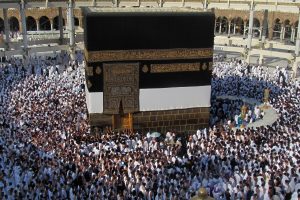MV Editor’s Note: The first of Dhul Hijjah may occur on or around the 2nd or 3rd (or 3rd and 4th) of September 2016 depending on the sighting/start method. Therefore the first of the three days of Eid should be either the 11th or 12th (or 12th or 13th) of September. May Allah, Most High, accept from the Ummah. These dates are a rough projection please check with a local authority to be certain. Read about the virtues of the month of Dhul Hijjah here.
Millions of Muslims are pouring into Islam’s holiest city of Mecca for the annual Islamic pilgrimage, Hajj, the religion’s fifth pillar.
The Prophet Muhammad (PBUH) received the divine instructions for Hajj in the ninth year of Hij’ra (Muslim migration from Mecca to Medina) when Allah decreed the performance of Hajj as a religious duty which must be carried out by every able-bodied Muslim who can afford to do so at least once in his or her lifetime (Qur’an, Chapter 3:97).
It is a collection of religious rituals performed from the eighth to the twelfth day of Dhul-Hijjah, the last month of the Islamic calendar. During these days, pilgrims are required to spend at least five days at specified locations around Mecca.
History:
The history of the Hajj dates back to 2,000 B.C. when Ismail, the infant son of the prophet Ibrahim (Abraham) and his (Ismail’s) mother Hajarah were stranded in the desert.
With Ismail close to death from thirst, Hajarah ran back and forth between the hills of Safa and Mar’wa looking for water until the angel Jibril (Gabriel) touched the earth and created a spring of fresh water known as the Well of Zamzam for the baby.
With Allah’s orders, Ibrahim built a monument (the sacred Ka’abah) at the site of the spring, paving way for the development of the city of Mecca. The Ka’abah remained in the control of polytheists until January 11, 630 AD (20th, Ramadhan 8AH) when Prophet Muhammad led Muslims to a peaceful takeover of the city from which they had been expelled.
Several idols that had been placed at the Ka’abah by the polytheists were destroyed and the sacred Ka’abah was once again rededicated to Allah. A year later, Muslims would return to this place, to perform the first official Hajj in the history of Islam.
Rituals:
The path that Prophet Muhammad and his followers took is retraced as part of the Hajj rituals which include making Hajarah’s walk between Safa and Mar’wa, stoning the wall of Satan that tempted Ibrahim to defy God, slaughtering an animal in honour of the sacrifice that Ibrahim made to save his son and climbing the Mount of Arafat from which Muhammad made his last sermon.
This year’s Hajj rituals will commence on Sunday October 13, when the pilgrims will enter the state of Ihram (cover up in two sheets of unsown cloth), and then join in processions to perform the Tawaf (circling the Ka’abah seven times), perform the Sa’ee (running back and forth between the hills of Al-Safa and Al-Marwah), drink from the Zamzam well, stand in vigil at the plains of Mount Arafat also known as Jabar-rahma (mountain of mercy) where Prophet Ibrahim attempted to sacrifice his son Ismail.
It is from this mountain that Prophet Muhammad also received the final revelation of the Qur’an when he delivered his farewell sermon in 631 AD.
After the performance of the evening prayer (Asr), the pilgrims move to Muz’daliffah where they stay until midnight and pick pebbles for stoning of the devil (Jamrat) in remembrance of the act of Prophet Ibrahim, his son Ismail and wife Hajarah, while chasing away Satan who was tempting them against Allah’s orders to sacrifice Ismail.
This is done on the tenth day of Dhul-Hijjah, the feast day for Eid-ul-Adhuha when Muslims world over sacrifice animals. The day will fall on the 11th or 12th (or 12th or 13th) of September.
From the Jamrat, the pilgrims offer their sacrifices and the men shave off their hair as the women only cut about a fingertip length and then proceed to Mecca for another round of the Tawaf and Sa’ee and end the state of Ihram.
The next three days (eleventh to thirteenth Dhul-Hijjah) are known as Ayyam Tashreek (days of drying the meat). Pilgrims spend the eleventh and twelfth nights in camp at Minah and perform the final ritual of stoning of the devil at the three Jamrats in the afternoon of the two days, after which, they head back to Mecca and end the pilgrimage.
By: Sadab Kitatta Kaaya
Source: muslimvillage.com










Comments